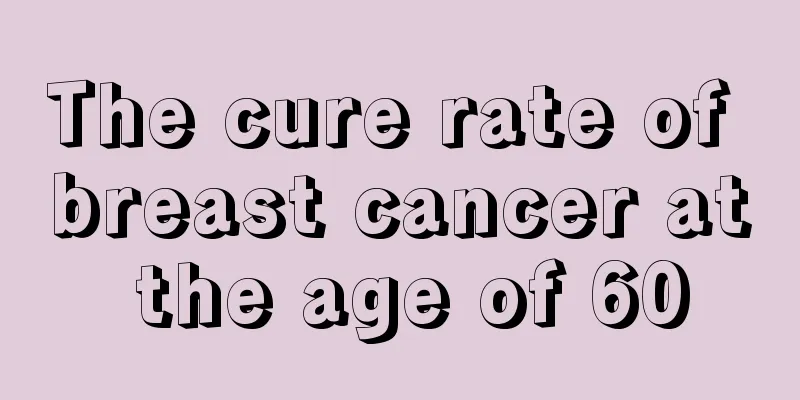The cure rate of breast cancer at the age of 60

|
The cure rate of breast cancer at the age of 60 varies depending on individual conditions, cancer stage and treatment methods. The cure rate of early breast cancer can be as high as 80%-90%, while the cure rate of late stage breast cancer is relatively low. However, through scientific treatment and active lifestyle improvement, survival time can still be significantly prolonged and quality of life can be improved. The following will analyze in detail the factors that affect the cure rate and the corresponding treatment plans. 1. Factors affecting the cure rate of breast cancer 1. Cancer staging Breast cancer is divided into stages 0 to 4. The earlier it is discovered, the higher the cure rate. For example, the cure rate of stage 0-1 breast cancer can reach more than 90% through surgery, radiotherapy, chemotherapy and other treatment methods; the cure rate of stage 2-3 is about 60%-80%; and the possibility of cure is lower in stage 4 because the cancer cells have spread to other organs, but individualized treatment can still be used to delay the disease. 2. The patient's physical condition Elderly patients generally have decreased organ function and immune levels, but as long as they do not have serious complications, they can still tolerate treatment. Doctors will design appropriate treatment plans based on the patient's specific conditions to avoid overtreatment or undertreatment. 3. Molecular typing and hormone receptor expression Breast cancer is divided into hormone receptor positive (such as ER/PR positive), HER2 positive and triple negative according to molecular classification. Among them, hormone receptor positive has a relatively good prognosis, HER2 positive has a significantly improved cure rate through targeted drug therapy (such as trastuzumab), while triple negative breast cancer is relatively challenging to treat, but new immunotherapy is expanding hope. 2. Treatment of breast cancer and improvement of prognosis 1. Surgery The main treatment for breast cancer is surgery, which is mainly divided into breast lumpectomy (breast-conserving surgery) and mastectomy. Breast-conserving surgery is preferred for patients in the early stage, and radiotherapy is combined with surgery to reduce the risk of recurrence; while patients in the late stage or with larger tumors may need mastectomy. 2. Medication - Hormone therapy: If the patient's breast cancer is hormone receptor-positive, tamoxifen or aromatase inhibitors can be used as adjuvant therapy to effectively reduce the risk of recurrence. -Chemotherapy: Mainly used for patients with advanced stage or high-risk disease. Typical drugs include paclitaxel, doxorubicin, etc., which can help delay or inhibit tumor development. -Targeted therapy: HER2-positive patients can significantly improve their survival rate with targeted drugs such as trastuzumab or pertuzumab, which has become the standard of treatment. 3. Radiotherapy It is particularly suitable for removing residual cancer cells after breast-conserving surgery or local tumor resection, thereby reducing the risk of local recurrence. Modern precision radiotherapy technology can effectively protect surrounding healthy tissues and greatly improve safety. 4. Lifestyle intervention -Dietary adjustment: It is recommended to supplement foods rich in antioxidants (such as green leafy vegetables, berries) and foods rich in omega-3 fatty acids (such as deep-sea fish) on a daily basis, and reduce the intake of high-fat and processed foods. -Moderate exercise: Low-intensity exercises such as walking and yoga can enhance immune function and improve patients' mood. 5. Mental health support Facing the diagnosis and treatment of breast cancer, the psychological pressure is heavy. Patients can seek help from professional psychological counseling or support groups to actively cope with the physical and mental challenges brought by the disease. 3. Comprehensive suggestions for improving cure rate Regular physical examinations and early diagnosis and treatment are the key to improving the cure rate of breast cancer patients over 60 years old. Early detection of breast lumps or abnormalities requires timely medical treatment; after diagnosis, you should discuss personalized treatment plans with your doctor and cooperate with your ideal lifestyle. For patients over 60 years old, as long as they actively cooperate with treatment, many cases can achieve long-term relief or even clinical cure. The joint efforts of doctors and patients will bring health and hope to more breast cancer patients. |
<<: The reason why women have fibroids. Can women with fibroids get pregnant?
>>: The difference between ampullary cancer and pancreatic cancer
Recommend
Can I eat pineapple after eating crayfish
The hot summer is here. It's a great pleasure...
What causes heel pain
The physical health of middle-aged and elderly pe...
Learn the importance of sharing
The Chinese nation has been a humble and friendly...
What are the early symptoms of liver cancer in men? How can men prevent liver cancer?
The main group of liver cancer patients are men. ...
What are the steps and methods of scalp massage
As we all know, the meridians and acupoints on th...
What to do if you have a fever caused by cold
Colds are very common diseases. Some people devel...
Compound Heparin Sodium Allantoin Gel
In our daily life, many people will have scars on...
What are the typical symptoms of liver cancer
What are the typical symptoms of liver cancer? So...
What should I do if I have chloasma on my face?
If you have chloasma on your face, you should pay...
What to do with swollen and painful hemorrhoids? Are there any folk remedies for treatment?
I believe that friends who have suffered from hem...
Can I eat mango after double eyelid surgery
Many people want their eyes to be big and round, ...
Pain in the back of the head and insomnia
Headache is a common symptom. There are many reas...
Where do herpes usually appear?
Herpes is a very common disease. Herpes can appea...
Are there serious side effects of gastroscopy under general anesthesia?
The diagnosis of gastrointestinal diseases requir...
What should I do if I have been catching a cold recently?
Summer is here and the weather is getting hotter ...









